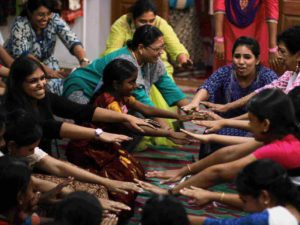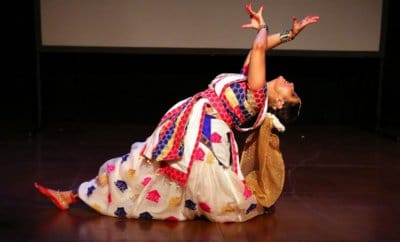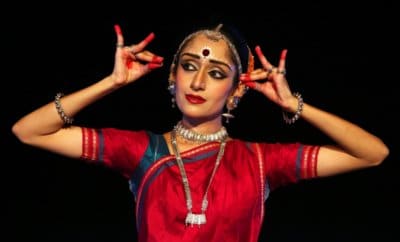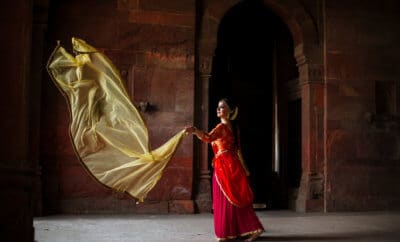Arts
Dancing Away the Blues: Movement Therapy Gains Ground in India

A session in progress at Creative Movement Therapy Association of India.
Therapists are using movement principles from Indian classical and western dance to help people manage physical and emotional issues.
Dance has been a part of our culture for a long time. Dance therapy, how ever, is relatively new,” says Tripura Kashyap, a pioneer in bringing movement therapy to India. It all started when Kashyap noticed that her younger brother, who has polio-meningitis, would sway to music.
“He would use his upper body and hands to bang at his wheelchair, to an extent that he almost fell off it,” the force behind the organization Creative Movement Therapy Association of India (CMTAI) tells Little India. “Sometimes, we would sway our bodies together to some of his favorite numbers and he seemed to be enthralled with the whole idea.”
This marked the beginning of an idea of how movement experiences can be used to help people with mental and physical disabilities in India. After a chance encounter with American dance movement therapist Dr. Grace Valentine in Bengaluru, Kashyap, a trained Bharatnatyam dancer from Kalakshetra in Chennai, went on to study at Hancock Center of Dance/Movement Therapy in Wisconsin.
Brinda Jacob Janvrin of Smart Move, a studio for movement arts and therapies, puts it quite simply: “Mental health is not just about the mind.” Janvrin, who practices Authentic Movement, elaborates upon the empowering nature of movement therapy. The clients are encouraged to close their eyes and move in front of the therapist, who acts as a witness. “It can be very empowering to understand and be aware of how your body is moving,” she explains. “It is an enlightening session for the therapist as well — to be conscious of your response to how someone is moving,” adds Janvrin, who has a studio at Ulsoor in Bengaluru.

A session in progress at Creative Movement Therapy Association of India.
Dance movement therapy (DMT) is being used extensively in the United States since World War II to help treat shell-shocked soldiers, sexual abuse victims and mentally ill patients. DMT works on a simple premise — the connect between the body and the mind.
Damini Sahay, a diploma holder in Dance Therapy from the Tata Institute of Social Sciences, Mumbai, says that her workshop series, Infinity, is designed to help women accept their sexuality. Sahay hopes to dispel the negative experiences that women often face with regard to their body. “Infinity is my baby. I created the format based on my experiences as a psychologist, my study in DMT and of course, the six years of being a belly dancer and a teacher,” she says. Sahay incorporates strengthening exercises, eye contact, verbal sharing of experiences and dancing as part of the workshop.
Organizations like Sohini Chakraborty’s Sanved use movement therapy to empower women from the red light district of Sonagachi in Kolkata.
The practice, however, is still at a nascent stage in India.
“Learning Movement therapy has brought a lot of self-awareness in me, especially with respect to my feelings,” says Sukriti, a 23-year-old former student of CMTAI who is currently working with an NGO. She aims to use DMT in mental health counselling. “I have become aware about how I deal with things in life, how things affect me and how I go about expressing them. This is something that I have always wanted to pursue ever since I had taken up Masters in Clinical Psychology,” she adds.
Sahay feels that dance can be empowering and belly dance, in particular, is a very empowering dance form. “Belly dance repertoire involves moving the hips, hair and chest and the society often skews these parts of a woman as vulgar,” she explains, adding that Western and Indian classical dance forms conveniently ignore these parts of the body. However, it is these movements through which women find a way to have new conversations with the body. It helps them let go of negative experiences associated with them.
“Usually, a negative emotion can make certain parts of your body rigid. The emotion could be something which is linked to the society, a sexual assault, or body image issues,” says Sahay.
Movement therapists feel funding from the government can make it accessible to a wider range of people. “In some cases, children who have undergone emotional or physical trauma find it less threatening to express themselves through movement or music,” says Kashyap, who in her book My Body, My Wisdom talks about the benefits of movement.
“It is not a dance class,” she clarifies. “A dance class is about technique and is goal-oriented, while a therapy session is process-oriented. We use movement principles from various forms of dance and apply them to what the goal of a particular session is.”
A typical movement therapy session begins with a warm up to prepare the body, theme development, which is the core of the session, a cooling down session involving relaxation techniques like martial arts and yoga and closure, where the participant verbally processes the session and their feelings. The goal of the session is how much a person takes back from the process — the movement expression and the cathartic verbal processing — into their daily lives.
Each movement therapy session — whether it is a group session or a private one — has a goal. “Of course, in a group therapy session, the initial part of the session focuses on building trust among the members of the group, to establish that it is a safe space for all,” Janvrin explains.
Indian philosophy has talked of the many benefits of art in healing people. Many movement therapists feel that the form and structure that has been added by the West is helping us rediscover the essence of healing through art. It has come back a full circle.
(With inputs from Cathline Chen)




You must be logged in to post a comment Login